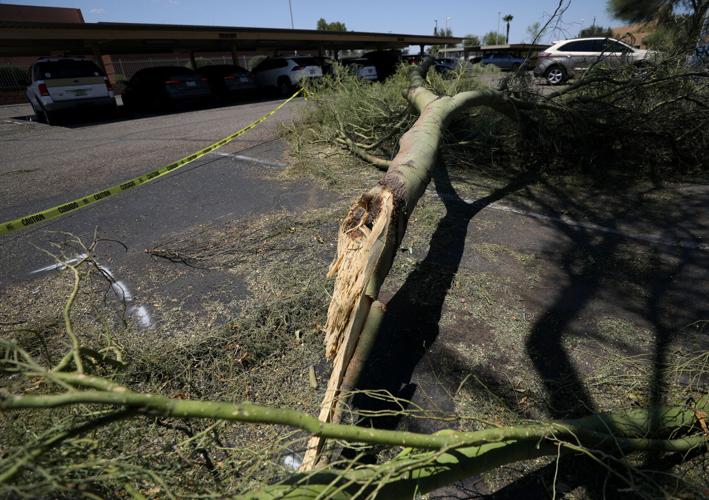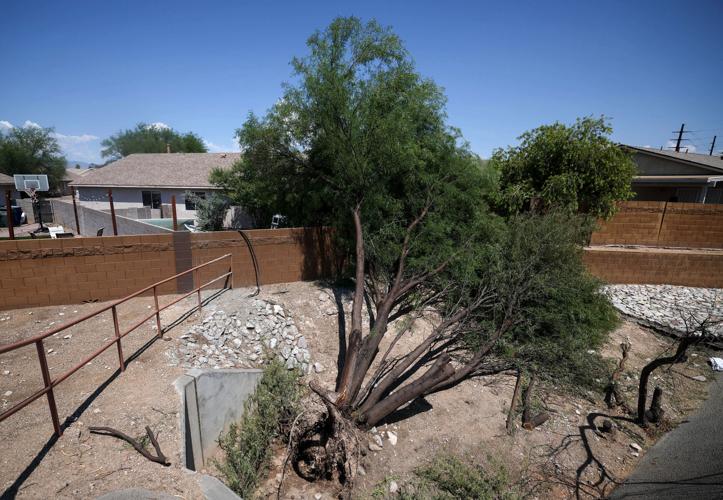The carnage from Sunday’s monsoon storm is still piling up at the Tank’s Green Stuff recycling yard on Ina Road, where trucks have been lining up all week to empty trailers filled with broken branches and fallen trees.
On Wednesday, mounds of still-green debris — most of it mesquite and palo verde — rose more than 10 feet high just inside the entrance to the facility. The line of tree-laden trucks waiting to get in stretched for about a third of a mile to the east on Ina and looped around a nearby QuikTrip convenience store.
Tank’s Green Stuff director Shota Austin said busy days are not unusual during monsoon season, but what they have experienced since Sunday is something else altogether.
“I’ve been here eight years, and I’ve never seen it like this,” he said. “This was an unusual storm with an unusual amount of damage.”
The July 14 weather system prompted rare tornado warnings in Tucson and produced straight-line wind gusts of up to 76 mph that damaged buildings, snapped limbs and toppled entire trees from downtown to Marana. One meteorologist for the National Weather Service called it the strongest monsoon storm he has seen in almost 20 years here.
The widespread wind damage has sparked a lively online debate among plant experts and casual gardeners about what kinds of trees should be planted in Tucson and how they should be cared for.

Jesus Loyo Togros unloads tree debris from his truck at Tank’s Green Stuff Ina Road Land Reclamation Facility, 5300 W. Ina Road in Tucson, Ariz., on July 17. After a monsoon storm early Sunday evening left widespread damage, trucks have been lining up with trailers filled with broken branches and fallen trees. The recent wind damage seen across the city has sparked debate among gardeners and plant scientists about the proper trees to plant and the proper way to care for them in desert environment prone to powerful monsoon weather events.
Two varieties in particular seem to be drawing the most criticism: non-native mesquite trees and a special kind of palo verde hybrid created about 40 years ago at the Arizona-Sonora Desert Museum.
In a post on the popular Tucson Backyard Gardening Facebook page on Monday, field biologist Sky Jacobs said hundreds of trees were felled by Sunday’s storm, and those two types seemed to make up the majority of the casualties.
“A continuing lesson we are learning again from the huge westside storm last night: Don’t plant hybrid or South American mesquites and Desert Museum palo verdes!” Jacobs wrote. “Both have terrible, small root systems and large canopies and just can’t stand up to the winds.”
Planting problem
Tucson-based desert ecologist Ben Wilder said he hasn’t seen any specific data on the kinds of trees that were damaged or uprooted by Sunday’s storm, but he’d like to. He thinks there might be a good scientific study to be done on the topic.
Anecdotally speaking, he said a lot of the toppled trees he has seen were in heavily irrigated areas like parks and cemeteries, where the water used to keep the grass green can also cause trees to outgrow their root systems.
“I’m seeing a lot of artificially large urban trees,” Wilder said.
He has also noticed trees down in places where they never had much chance to establish roots in the first place, namely on traffic medians and in parking lots and other confined spaces.
Amy Belk is a certified arborist and the horticulture manager for Pima County’s Native Plant Nursery.

Jose Logu unloads tree debris from his truck at Tank’s Green Stuff Ina Road Land Reclamation Facility, 5300 W. Ina Road in Tucson, Ariz., on July 17.
She said hybrid, South American mesquites and Desert Museum palo verdes do have a reputation for being uprooted by wind gusts far less intense than the ones on Sunday.
“I have personally seen a lot of them blown over in storms throughout the years, but they also happen to be a couple of the top selling trees in our market,” she said. “They’re available at every big box store and every wholesale nursery, and they’re planted in every new tract house or commercial landscape, so of course we see them everywhere we look.”
While it’s true that some species are better suited than others to handle strong winds, any tree can fail if subjected to what Belk called “nursery culture, misguided planting or poor maintenance practices.”
“Trees purchased from nurseries are often already rootbound,” she said, “and the problem is often made worse when water isn’t applied to the proper depth or in the proper places to encourage a deeper, wider root system over time.”

A palo verde tree lays on the ground in a parking lot off of Bonita Avenue on Wednesday, July 17. The tree was part of the carnage from Sunday’s monsoon storm.
Improper pruning practices can also leave trees vulnerable to wind damage, and the likelihood of failure only increases for trees in extremely waterlogged soil, Belk said.
In the end, though, all the careful placement and maintenance in the world can’t save even the strongest of trees from conditions like the ones that struck Tucson on Sunday.
“Some storm events are just too intense for any species in its path to come through unscathed, and this was one of them,” she said.
The wrong tree?
Mark Dimmitt invented the Desert Museum palo verde, but he isn’t bothered by all the criticism of his creation.
“It’s far from a perfect tree,” said the long-time Tucson horticulturist, who previously served as the Desert Museum’s director of natural history.
Dimmitt created the hybrid in the early 1980s by crossing three other palo verdes: the Mexican, blue and foothills varieties. The result was a fast-growing tree with smaller, less messy leaves, large blossoms, a longer flowering season and no thorns at all.
But the trade-off for rapid growth turned out to be brittle branches and a comparatively short lifespan overall. The hybrid also proved to be especially vulnerable to fatal infestations by a certain kind of spider mite.
Dimmitt said the Desert Museum began selling his carefully crafted palo verde in the mid-1980s but never sought a patent for it because no one thought it would take off. Before long, though, the hybrid was being mass-produced, sold at big-box nurseries and planted by landscapers across the Southwest.
“Another missed chance to retire early,” he joked.
None of Dimmitt’s trees were blown down in Sunday’s storm, but he did lose some limbs at his west-side property, where he maintains a garden and several greenhouses filled with unusual plants.
A few of the branches that broke off came from his own Desert Museum palo verdes, including one that he waters regularly and another, smaller one that is not irrigated.

A large uprooted mesquite tree hangs over two residential homes days after a monsoon storm brought strong winds and rainfall on Sunday, South Kino Parkway, Tucson, Ariz., July 17.
“It was a doozy of a storm, and we’re probably going to have more of them, because (the climate) is getting warmer,” he said. “That’s basic physics. Heat is energy.”
Ultimately, Dimmitt said he doesn’t know of a perfect tree to plant in Tucson, but the ironwood probably comes the closest to being monsoon-storm-proof. You just have to be patient, because they can take a long time to grow, he said. “You’re going to wait 50 years before you have a picnic under one.”
Out on a limb
Back at Tank’s Green Stuff, Austin said the staff was doing what they could to keep the lines of trucks moving.
They started opening the gates and letting customers in about 30 minutes early in the morning and staying open as much as an hour late in the afternoon.
“And we’re trying to get everyone on and off the scale in a minute,” he said.
The green storm debris piling up at the Ina Road yard and at Tank’s other facilities on Speedway east of Kolb and Wilmot south of I-10 will eventually be turned into compost, topsoil, biofuel and other products.
The dramatic spike in traffic early in the week was something of a perfect storm for Tank’s, according to CEO Jason “Tank” Tankersley. He said several staff members were off work or home sick with COVID at the Ina facility, when 282 loads of green waste rolled through the gate on Tuesday alone — roughly twice the volume they see on a typical day.
“I’ve never seen traffic (backed up) all the way out to I-10,” Tankersley said. “It was definitely a juggling act.”
Meanwhile, Tank’s Speedway location is still recovering from its own storm damage. Tankersley said wind from a monsoon microburst a few weeks ago tore apart a coverall structure that housed the company’s bagging facility for packaging its products. Then came a heavy downpour that flooded some of the exposed equipment.
‘We’re kind of sharing the pain of the community,” he said.
Damage assessment
As of late in the week, city and county officials were still tallying up how many trees on public property were damaged or uprooted by Sunday’s powerful storm.
“‘A lot’ is the best we can do,” said Pima County spokesman Mark Evans in an email. “We had trees down at numerous county facilities, trees down at parks, trees down along the Loop, and trees or large branches down along numerous roads. There were too many to count.”
Belk said roughly half a dozen trees sustained significant damage at the headquarters for Parks and Recreation and neighboring Pima Prickly Park at the west end of River Road.
A few trees were blown down entirely, including a native mesquite and a blue palo verde, two varieties that tend to be less prone to toppling over. Several other trees were damaged beyond repair and had to be removed.
“This happened to tree species across the board, but older trees often sustain more of this type of damage,” Belk said. “The older blue palo verde trees at our location took heavy damage, but the younger Desert Museum palo verde that is planted nearby didn’t suffer any damage at all.”






